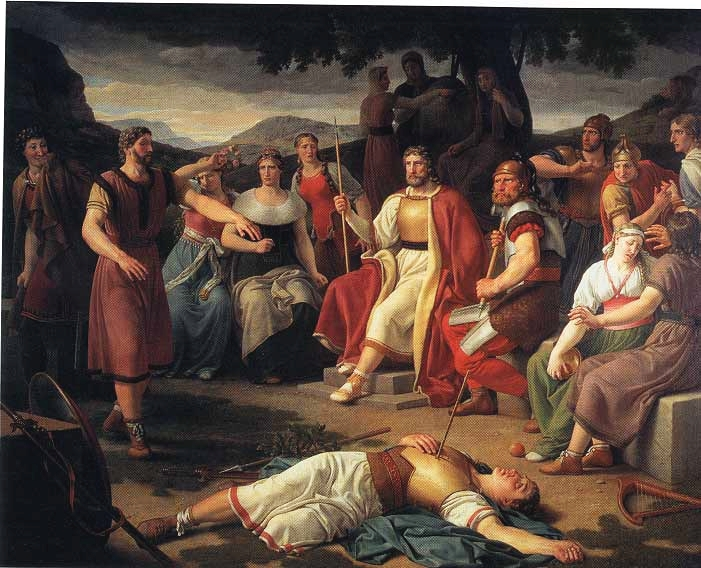HODR

“Baldur’s Death” by Christoffer Wilhelm Eckersberg (1817). Hodr stands to the left of the dead god.
Hodr (pronounced “HO-der”; from Old Norse Höðr, “Warrior”[1]) is a Scandinavian god whom we know only from a single episode in Norse mythology: the death of Baldur.
Two widely divergent versions of this story exist. The more familiar of the two (the one recounted in the above link) comes from the Prose Edda of the medieval Icelander Snorri Sturluson. As Snorri tells it, the god Baldur, who is here portrayed as being a charming, beloved, innocent sufferer, had dreams that foretold his imminent death. His mother, Frigg, went around and obtained oaths from everything in the world that they would not harm her son. The only being she omitted was the mistletoe, as she thought it to be too small and harmless a thing to be of any real consequence in this matter. When the wily trickster Loki discovered this oversight, he fashioned a mistletoe spear.
While all the gods were amusing themselves by throwing every available projectile at Baldur and laughing as the things bounced off of their unharmed companion, Loki approached Hodr – here portrayed as blind and rather gullible – with the mistletoe spear. He convinced Hodr to throw the spear at Baldur to contribute to the game and to honor the strength of his brother. (Hodr and Baldur were both sons of Odin.) With Loki guiding his hand, Hodr launched the spear at Baldur. The weapon pierced him, and, to the shock and horror of all present, he fell down dead on the spot.
Hodr was later killed by Baldur’s avenger, Vali, who seems to have been conceived specifically for this purpose.[2]
The other version of this tale comes from Gesta Danorum, “The History of the Danes,” by the medieval Danish historian Saxo Grammaticus. Here, Hodr is far from the passive pawn that Snorri makes him out to be. Saxo’s Hodr (Latinized as “Hotherus”) is a character whose personality and deeds accord better with his name, which, as noted above, means “Warrior.”
Hodr and Baldur were two great war leaders who marshaled their armies against each other due to a dispute over the hand of the beautiful maiden Nanna. Baldur had been nourishing himself with a special, spiritual food that conferred invincibility, and Hodr knew that he would be unable to defeat Baldur by normal means. So Hodr undertook a long and perilous journey to the underworld. There, he obtained a weapon that had been charged with magical powers that would enable him to overcome Baldur’s own magically-induced strength. Soon thereafter, Hodr wounded Baldur in combat, and Baldur died of his wounds some days later. However, Hodr was then himself slain by Baldur’s avenger, who is here called “Bous.”[3]
These two stories are similar enough that they must point back to the same basic tale. Yet they also differ in several definitive respects, not the least of which is Hodr’s character.
Imagine for a moment that Snorri’s version of the tale was the only one that had survived down to the present day. This is, in fact, the case for many of the stories that Snorri relates. His version of Baldur’s death is clearly far from the full picture, and his account cannot be taken at face value.
Of course, the same must be said for Saxo’s version. Saxo and Snorri had overlapping but divergent aims, and whatever their own additions to the tale might have been – and whatever the motives behind their additions might have been – they could have been drawing from different versions of the tale in the first place. Regardless of the reasons behind the two narratives’ differences, however, it’s clear that we have two versions as different in spirit as they are in the details, and that neither of them give anything like the whole picture.
This example should serve to caution us against taking the primary sources too literally, as if they were untarnished accounts of how the heathen northern Europeans saw the world. They point back to the ancient northern European worldview, yes, but that worldview is often visible only opaquely, and hidden beneath layers of later accretions. The sources are the starting points for our knowledge of the pre-Christian Germanic world, but they are not the ending points. A rigid “stick to the sources” approach will only lead us astray and allow us to be bamboozled by Snorri and the like, just as Snorri’s overly-trusting Hodr was by Loki. To fill in the gaps, to restore much of what has been lost, we need an approach that is at the same time more critical and more intuitive. We must identify elements that are common to multiple sources, fit them together to form a more comprehensive framework, and add uncorroborated details only cautiously and tentatively.
Finally, if you want to learn more about the Nordic shamanism’ conception of learning and experiences in general .
Looking for more great information on Nordic shamanism? While this site provides the ultimate online introduction to the topic, my book Northern shaman provides the ultimate introduction by an Völva and a shaman who are not like the others . I’ve also written a popular list of The 10 Best Norse Mythology Books, which you’ll probably find helpful in your pursuit.
References:
[1] Simek, Rudolf. 1993. Dictionary of Northern Mythology. Translated by Angela Hall. p. 155.
[2] Snorri Sturluson. The Prose Edda. Gylfaginning 48 and Skáldskaparmál 13.
[3] Saxo Grammaticus. Gesta Danorum.



Create Your Own Website With Webador